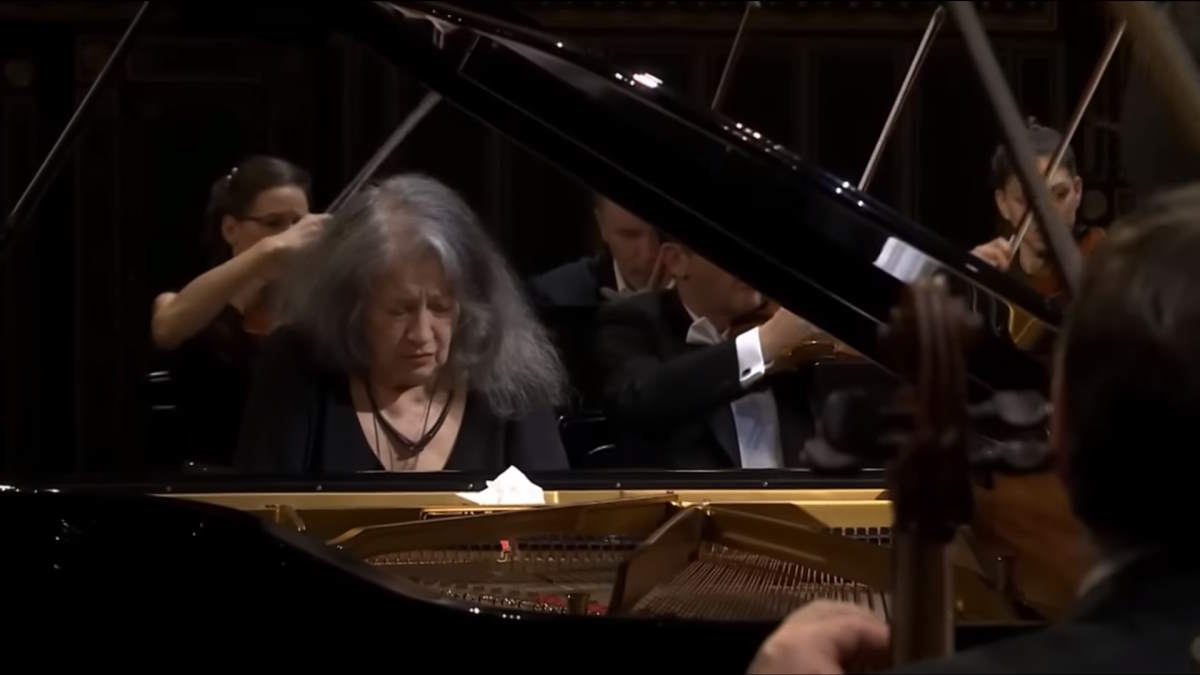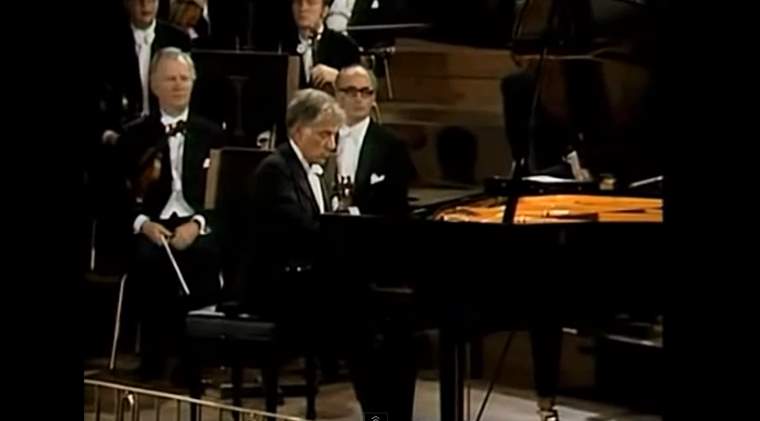Accompanied by the Franz Liszt Chamber Orchestra, the great Argentine pianist Martha Argerich performs Ludwig van Beethoven’s Piano Concerto No. 1 in C major, Op. 15. Conductor: Gábor Takács-Nagy. This performance was recorded at the Liszt Ferenc Academy of Music, Budapest, in December 2019. Encores: Bach, Gavottes from the English Suites, and Scarlatti, Keyboard Sonata, K. 141.
Beethoven’s Piano Concerto No. 1
Beethoven’s Piano Concerto No. 1 in C major, Op. 15, is a remarkable work that showcases the composer’s early prowess and innovative spirit. Composed between 1795 and 1800, it was dedicated to one of Beethoven’s patrons, Baron Gottfried van Swieten. Although it is labeled as his first piano concerto, it was actually written after his Piano Concerto No. 2, but published first, hence the numbering.
This concerto reflects Beethoven’s emerging style while still showing the influence of Mozart and Haydn. It bridges the Classical and early Romantic eras, with Beethoven injecting his own distinctive voice into the established concerto form. The orchestration is bright and energetic, featuring the piano in a prominent role that demands both technical skill and expressive nuance from the performer.
The concerto opens with a grand and spirited orchestral introduction that sets the stage for the piano’s entrance. Throughout the work, the interplay between the soloist and the orchestra is dynamic and engaging, with the piano often taking the lead in thematic development and virtuosic passages. Beethoven’s writing for the piano is both challenging and rewarding, filled with intricate runs, powerful chords, and lyrical melodies that highlight the instrument’s full range.
The concerto is also notable for its structural innovations and harmonic exploration. Beethoven’s use of unexpected modulations and his expansion of traditional forms were groundbreaking at the time. These elements contribute to the work’s sense of drama and forward momentum, keeping the listener engaged from beginning to end.
The cadenza sections in the concerto, particularly those written by Beethoven himself, are a showcase of the pianist’s virtuosity and interpretative skill. They allow the soloist to explore the themes more freely and demonstrate their technical prowess, often leading to a thrilling conclusion.
Beethoven’s Piano Concerto No. 1 in C major is a vital part of the piano concerto repertoire. It exemplifies Beethoven’s early genius and his ability to innovate within the classical framework. The concerto is celebrated for its vibrant energy, technical demands, and the seamless integration of the piano and orchestra, making it a favorite among pianists and audiences alike.
Movements
1. Allegro con brio
The first movement of Beethoven’s Piano Concerto No. 1 in C major, Op. 15, is marked Allegro con brio and sets the tone for the entire concerto with its energetic and spirited character. This movement is structured in the classical sonata-allegro form, featuring an exposition, development, recapitulation, and coda.
The movement begins with a grand and confident orchestral introduction, presenting the primary themes that will be explored throughout. The opening theme is assertive and vigorous, characterized by bold, rhythmic figures and a bright, major-key tonality. This theme is followed by a more lyrical and flowing secondary theme, providing contrast and showcasing Beethoven’s gift for melody.
After the orchestra establishes these themes, the piano makes its entrance with a flourish, echoing the opening motif and immediately capturing the listener’s attention. The soloist then embarks on a dialogue with the orchestra, taking the themes through a series of variations and embellishments. Beethoven’s writing for the piano in this movement is both virtuosic and expressive, featuring rapid scales, arpeggios, and dynamic contrasts that highlight the performer’s technical skill and interpretative ability.
In the development section, Beethoven takes the thematic material through various keys and transformations, creating a sense of tension and exploration. This part of the movement is characterized by its harmonic complexity and the interplay between the piano and orchestra, with frequent modulations and unexpected turns that keep the listener engaged.
The recapitulation brings back the main themes, now with the piano and orchestra fully integrated, reinforcing the movement’s sense of cohesion and unity. The themes are revisited with new variations and elaborations, showcasing Beethoven’s creativity and ingenuity.
As the movement approaches its conclusion, the soloist performs a cadenza-a virtuosic, unaccompanied passage that allows the pianist to display their technical prowess and interpretive skill. Beethoven wrote several cadenzas for this concerto, each offering a different perspective on the thematic material. The cadenza typically features rapid runs, intricate fingerwork, and dramatic contrasts, leading to a thrilling and climactic finish.
The movement concludes with a lively and exuberant coda, bringing together the piano and orchestra for a final, emphatic statement. This ending reinforces the movement’s overall sense of vitality and joy, leaving the audience with a sense of exhilaration and anticipation for the rest of the concerto. The Allegro con brio movement of Beethoven’s Piano Concerto No. 1 is a brilliant example of his early style, combining classical form with innovative elements that hint at his later, more revolutionary works.
2. Largo
The second movement of Beethoven’s Piano Concerto No. 1 in C major, Op. 15, is marked Largo, providing a striking contrast to the energetic and exuberant first movement. This slow movement is set in the key of A-flat major, which offers a warm and lyrical character, creating a serene and contemplative atmosphere.
The movement opens with a gentle and expressive orchestral introduction, featuring a delicate, singing melody primarily carried by the strings. This sets the stage for the solo piano’s entrance, which introduces the main theme with a sense of calm and introspection. The piano’s melody is lyrical and flowing, with Beethoven employing a simple yet deeply expressive style that allows for a wide range of emotional nuances.
Throughout the Largo, the dialogue between the piano and the orchestra is intimate and conversational. The piano’s role is more reflective and subdued compared to the first movement, focusing on melodic beauty and expressive depth rather than technical virtuosity. The orchestral accompaniment provides a rich harmonic backdrop, enhancing the piano’s lyrical lines with subtle and supportive textures.
Beethoven’s use of dynamics and phrasing in this movement is particularly masterful. The music often shifts from soft, delicate passages to more intense and dramatic moments, creating a sense of ebb and flow that mirrors the emotional landscape of the piece. The interplay of light and shadow, calm and tension, gives the movement a profound sense of depth and complexity.
The middle section of the Largo introduces a contrasting theme, which is more rhythmically active and harmonically adventurous. This section allows for greater interplay between the piano and orchestra, with the soloist weaving intricate embellishments around the orchestral lines. Despite the increased activity, the music retains its overall sense of tranquility and introspection.
As the movement progresses, Beethoven returns to the original theme, now enriched by the developments of the middle section. The piano and orchestra engage in a final, heartfelt dialogue, bringing the movement to a gentle and contemplative close. The ending is marked by a sense of quiet resolution, with the piano softly restating the main theme before fading into silence.
The second movement of Beethoven’s Piano Concerto No. 1 is a beautiful and expressive contrast to the lively first movement. It showcases Beethoven’s ability to create deeply moving music through simple, lyrical melodies and rich, harmonic textures. The Largo’s serene and introspective character provides a moment of reflection and emotional depth, enhancing the overall impact of the concerto.
3. Rondo. Allegro scherzando
The third movement of Beethoven’s Piano Concerto No. 1 in C major, Op. 15, is marked Rondo: Allegro scherzando. This lively and spirited movement serves as a joyful and energetic conclusion to the concerto, showcasing Beethoven’s playful and inventive side.
The rondo form, characterized by the recurring main theme (refrain) interspersed with contrasting episodes, provides a framework for this movement’s exuberant character. The main theme is introduced by the piano, immediately capturing the listener’s attention with its bright, rhythmic vitality and catchy melody. This theme is marked by a playful, almost dance-like quality, reflecting the “scherzando” (joking or playful) indication in the tempo marking.
After the initial presentation of the main theme, the orchestra picks it up, creating a lively dialogue between the soloist and the ensemble. This interaction between the piano and orchestra is a hallmark of the movement, with the piano often leading the way and the orchestra responding, or vice versa. The alternation between the piano’s brilliant passages and the orchestra’s rich textures adds to the movement’s dynamic and engaging nature.
The contrasting episodes (couplets) in the rondo form provide variety and further showcase Beethoven’s creativity. These sections explore different keys and thematic material, offering moments of contrast to the recurring main theme. One of the episodes features a more lyrical and flowing melody, providing a brief respite from the movement’s overall exuberance before returning to the lively rondo theme.
Beethoven’s writing in this movement is virtuosic and demands a high level of technical skill from the pianist. The soloist navigates rapid scales, intricate runs, and playful rhythmic figures with agility and precision. The piano part is not only technically challenging but also expressive, allowing the performer to bring out the movement’s character and charm.
As the movement progresses, Beethoven introduces variations and embellishments to the main theme, keeping it fresh and engaging each time it returns. The playful nature of the music is maintained throughout, with the composer incorporating unexpected twists and turns that add to the movement’s sense of fun and spontaneity.
The cadenza towards the end of the movement provides a final opportunity for the soloist to shine. This unaccompanied section showcases the pianist’s virtuosity, featuring dazzling runs and dramatic flourishes. Beethoven often wrote his own cadenzas for his concertos, and this one is no exception, highlighting his skill as both a composer and performer.
The movement concludes with a spirited and jubilant coda, bringing the concerto to a rousing and satisfying close. The piano and orchestra join forces for a final, emphatic statement of the main theme, ending the work on a high note. The Rondo: Allegro scherzando is a brilliant and joyful finale, leaving the audience with a sense of exhilaration and showcasing Beethoven’s mastery of the concerto form.
Sources
- Piano Concerto No. 1 (Beethoven) on Wikipedia
- Piano Concerto No.1, Op.15 (Beethoven, Ludwig van) on the International Music Score Library Project website



